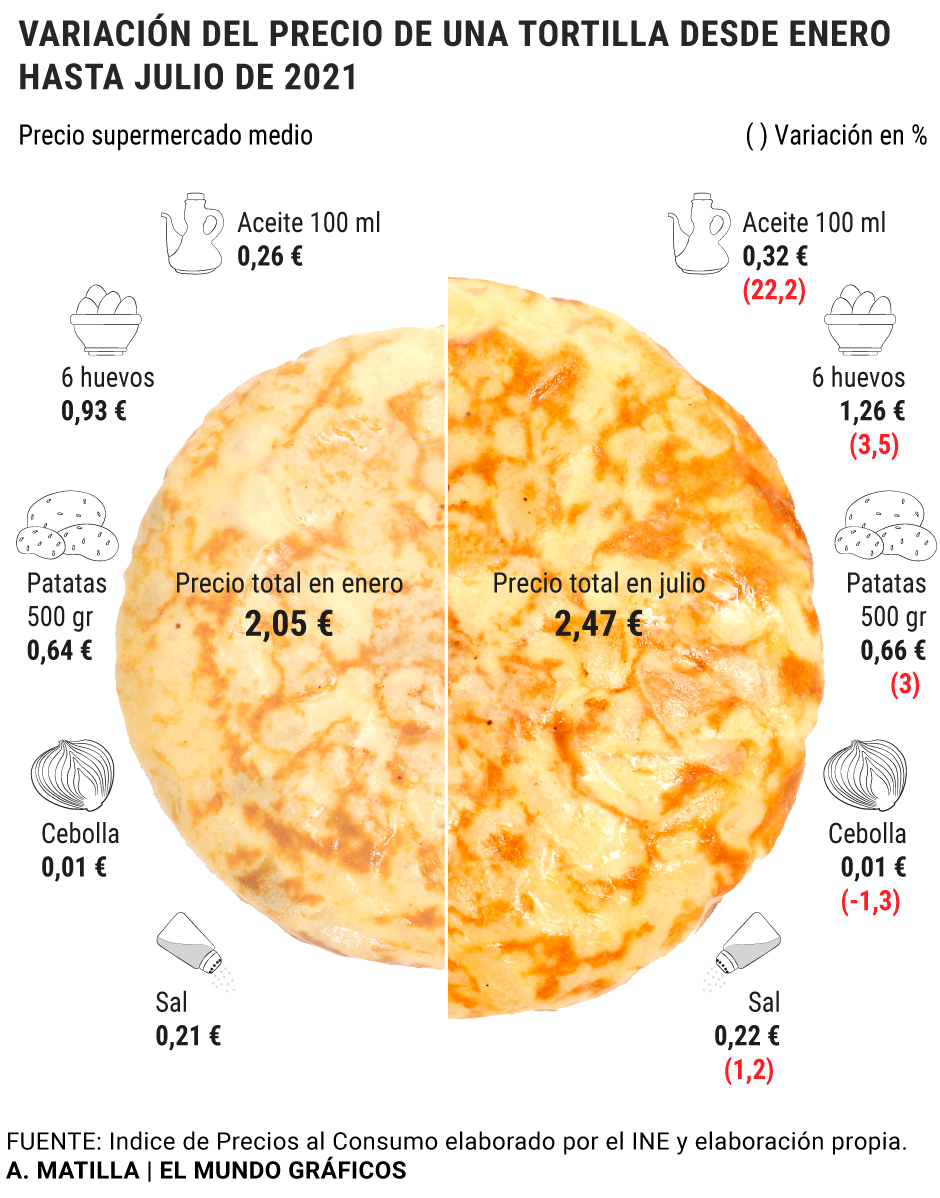Ingredients of an omelette for four people: half a kilo of potatoes, six eggs, olive oil until the potatoes are covered, salt and, for lovers of discord, half an onion.
Estimated preparation time: 30 minutes.
Estimated price:
at least 20'48% more than last year.
The shopping basket has suffered an exponential increase in the last months of the pandemic. The
National Institute of Statistics (INE)
published last Monday that the annual variation of the general CPI -the short-term indicator that measures the evolution of consumer goods and services acquired in Spanish households- in August of this year was
3 ' 3%
. An increase of
0.4% compared to the CPI of July this year
.
Both data are
provisional estimates still pending revision
, although the Institute's communication office has advanced that they do not usually vary too much. If confirmed, this would be
the highest rise in the CPI in the last 9 years
. This increase goes from the statistic to the kitchen table. Thus, following the INE's evaluations,
if
in July 2020 making an omelette for four cost around 2.05 euros, it currently costs about 2.47 euros.
Among the reasons for this increase, the INE highlights "the rise in electricity prices, higher this month than in August last year." If consumers are paying the exorbitant rise in the prices of electricity in their homes - which reached a new record yesterday Tuesday with
130 euros per MW / hour
- now they
will
also
have to pay it indirectly in their shopping cart
. This represents a "double bill" for consumers, as described weeks ago by
Enrique García, spokesman for the Organization of Consumers and Users (OCU)
, which already last month warned of the impact that the rise in the price of electricity could have on the increase in the price of the shopping basket.
And, as indicated by the consumer association,
energy affects the entire production and distribution chain
. From the cold rooms that preserve food to the machinery to process it to the gasoline of the vehicle that transports it. However, not all parts of the chain consider that their role in the final increase in the CPI is the same.
"It is not a question of blaming the oil sector for the increase in the CPI," says
Manuel Alfaro, president of the Spanish Federation of Industrial Olive Oil Manufacturers
. The case of oil is exemplary. According to the annual variation of the CPI, oil is one of the products that has undergone the greatest increase in recent months, reaching an
annual variation of 21.6% in July
of this year. Although, according to Alfaro,
"the current price is not the highest compared to previous years
.
"
"To transform a kilo of olive into oil we need electricity, and due to its increase the costs have increased by around
21%
". This rise in chain lasts until the arrival of the product at the store. In this sense, Alfaro points out that "the bottling companies also need electricity to bottle the products." The Federation assures that
this increase in costs has not been transferred to consumers
, since their contracts are for six months and in that period "they establish fixed, closed prices."
The increase in the CPI is also affected by another phenomenon: that of
"the volatility of the harvest"
, which marks the rise or fall of prices depending on the success of
the harvest
. Thus, when production exceeds demand - established around 2.8 million tons in the case of oil, according to Alfaro - there is a surplus and prices fall, something that has been happening with the oil harvest in the last years. On the other hand, "this year it has not reached those 2.8 million that the world production market consumes, which increases demand and prices," explains the president of the Federation. Therefore, according to their estimates, in July of last year the price of extra virgin olive oil was
2 '
35 euros a liter and today it is at
3.35 euros
approximately.
This price dance between supply and demand, as well as the rise in production and distribution costs related to electricity, affects the sectors with more or less competition unevenly.
As Manuel García explains,
"in an environment where there is competition it will be more difficult to pass on the rise in prices to the consumer
, while in one without competition, this rise will have more impact on consumers."
In turn, the OCU spokesman adds another explanation to the reasons for the rise in the CPI, and indicates that this "has to do with the
expectations of the recovery
." A speculative trend that moves in line with demand, reactivated thanks to the return to post-pandemic "normality". In this sense, light augurs at the end of the tunnel.
"Inflation will stabilize as normality in lifestyle stabilizes
.
"
Whatever the diagnosis, the current rise in prices "has a special impact on the most disadvantaged economies," reflects García.
It refers to the
45%
of the population who, according to their own estimates, have seen their income reduced during the pandemic.
"The higher the percentage of their income that they spend on these basic products, the worse they will spend it."
According to the criteria of The Trust Project
Know more
INE
economy
HBPR
IPC Prices soar to 2.9%, the highest rate in 4 years awaiting the impact of the electricity crisis
Unemployment Double punishment for those over 55: 15% more unemployment and with the generation of the two crises in their charge
Music15 years of Spotify: how long can you keep losing money?
See links of interest
Last News
Holidays 2021
Home THE WORLD TODAY
Podcast Economia
Stage 16, live: Laredo - Santa Cruz de Bezana

